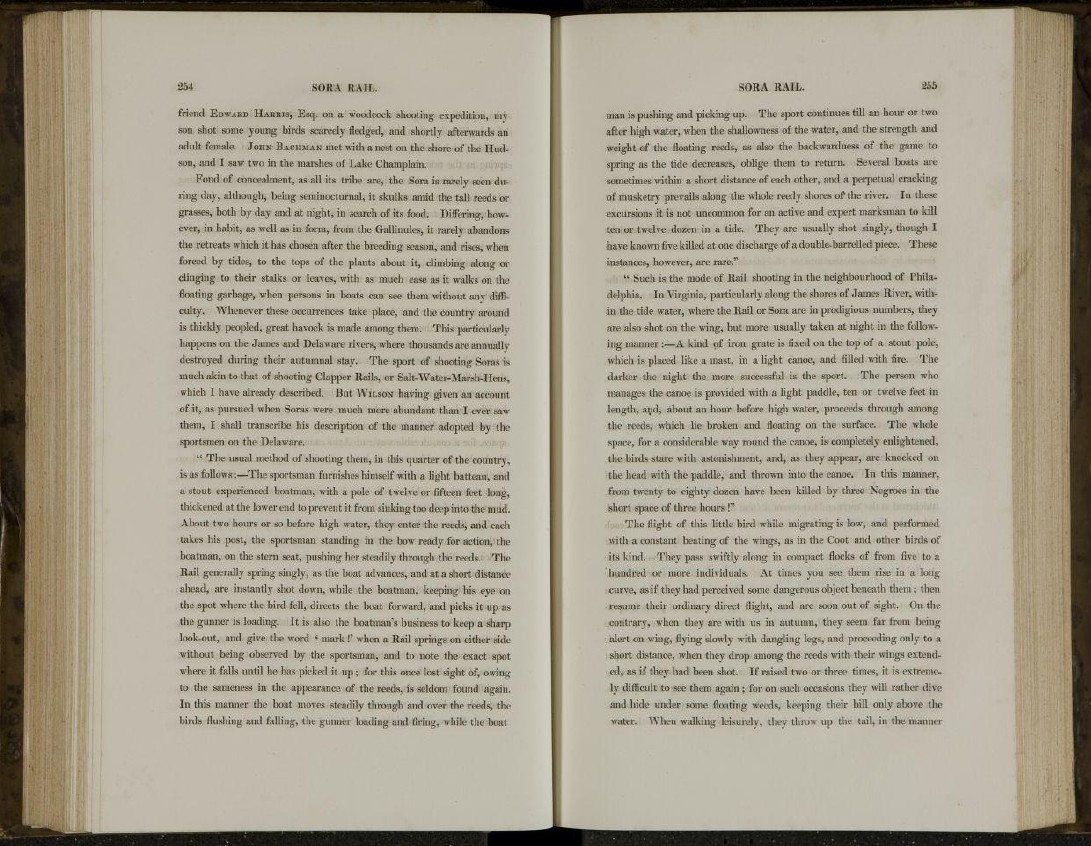
friend EDWARD HARRIS, Esq. on a woodcock shooting expedition, my
son shot some young birds scarcely fledged, and shortly afterwards an
adult female. JOHN BACHMAN met with a nest on the shore of the Hudson,
and I saw two in the marshes of Lake Champlain.
Fond of concealment, as all its tribe are, the Sora is rarely seen during
day, although, being seminocturnal, it skulks amid the tall reeds or
grasses, both by day and at night, in search of its food. Differing, however,
in habit, as well as in form, from the Gallinules, it rarely abandons
the retreats which it has chosen after the breeding season, and rises, when
forced by tides, to the tops of the plants about it, climbing along or
clinging to their stalks or leaves, with as much ease as it walks on the
floating garbage, when persons in boats can see them without any difficulty.
Whenever these occurrences take place, and the country around
is thickly peopled, great havock is made among them. This particularly
happens on the James and Delaware rivers, where thousands are annually
destroyed during their autumnal stay. The sport of shooting Soras is
much akin to that of shooting Clapper Rails, or Salt-Water-Marsh-Hens,
which I have already described. But WILSON having given an account
of it, as pursued when Soras were much more abundant than I ever saw
them, I shall transcribe his description of the manner adopted by the
sportsmen on the Delaware.
" The usual method of shooting them, in this quarter of the country,
is as follows:—The sportsman furnishes himself with a light batteau, and
a stout experienced boatman, with a pole of twelve or fifteen feet long,
thickened at the lower end to prevent it from sinking too deep into the mud.
About two hours or so before high water, they enter the reeds, and each
takes his post, the sportsman standing in the bow ready for action, the
boatman, on the stern seat, pushing her steadily through the reeds. The
Rail generally spring singly, as the boat advances, and at a short distance
ahead, are instantly shot down, while the boatman, keeping his eye on
the spot where the bird fell, directs the boat forward, and picks it up as
the gunner is loading. It is also the boatman's business to keep a sharp
look-out, and give the word * mark !' when a Rail springs on either side
without being observed by the sportsman, and to note the exact spot
where it falls until he has picked it up; for this once lost sight of, owing
to the sameness in the appearance of the reeds, is seldom found again.
In this manner the boat moves steadily through and over the reeds, the
birds flushing and falling, the gunner loading and firing, while the boat
man is pushing and picking up. The sport continues till an hour or two
after high water, when the shallowness of the water, and the strength and
weight of the floating reeds, as also the backwardness of the game to
spring as the tide decreases, oblige them to return. Several boats are
sometimes within a short distance of each other, and a perpetual cracking
of musketry prevails along the whole reedy shores of the river. In these
excursions it is not uncommon for an active and expert marksman to kill
ten or twelve dozen in a tide. They are usually shot singly, though I
have known five killed at one discharge of a double-barrelled piece. These
instances, however, are rare."
" Such is the mode of Rail shooting in the neighbourhood of Philadelphia.
In Virginia, particularly along the shores of James River, within
the tide water, where the Rail or Sora are in prodigious numbers, they
are also shot on the wing, but more usually taken at night in the following
manner :—A kind of iron grate is fixed on the top of a stout pole,
which is placed like a mast, in a light canoe, and filled with fire. The
darker the night the more successful is the sport. The person who
manages the canoe is provided with a light paddle, ten or twelve feet in
length, and, about an hour before high water, proceeds through among
the reeds, which lie broken and floating on the surface. The whole
space, for a considerable way round the canoe, is completely enlightened,
the birds stare with astonishment, and, as they appear, are knocked on
the head with the paddle, and thrown into the canoe. In this manner,
from twenty to eighty dozen have been killed by three Negroes in the
short space of three hours !"
The flight of this little bird while migrating is low, and performed
with a constant beating of the wings, as in the Coot and other birds of
its kind. They pass swiftly along in compact flocks of from five to a
hundred or more individuals. At times you see them rise in a long
curve, as if they had perceived some dangerous object beneath them; then
resume their ordinary direct flight, and are soon out of sight. On the
contrary, when they are with us in autumn, they seem far from being
alert on wing, flying slowly with dangling legs, and proceeding only to a
short distance, when they drop among the reeds with their wings extended,
as if they had been shot. If raised two or three times, it is extremely
difficult to see them again; for on such occasions they will rather dive
and hide under some floating weeds, keeping their bill only above the
water. When walking leisurely, they throw up the tail, in the manner